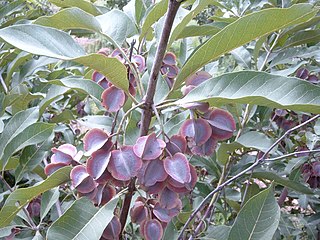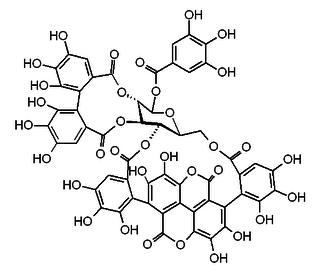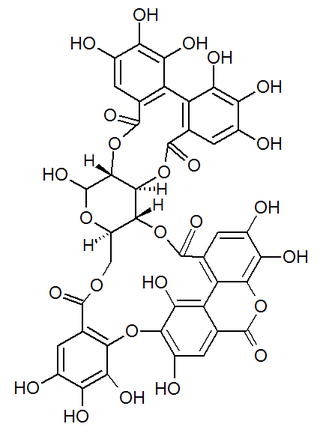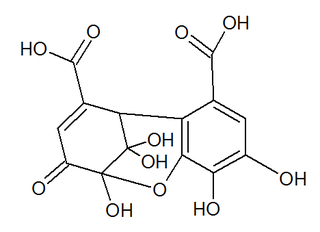
Tannins are a class of astringent, polyphenolic biomolecules that bind to and precipitate proteins and various other organic compounds including amino acids and alkaloids.

Combretum, the bushwillows or combretums, make up the type genus of the family Combretaceae. The genus comprises about 272 species of trees and shrubs, most of which are native to tropical and southern Africa, about 5 to Madagascar, but there are others that are native to tropical Asia, New Guinea and the Bismarck Archipelago, Australia, and tropical America. Though somewhat reminiscent of willows (Salix) in their habitus, they are not particularly close relatives of these.

1-α-O-Galloylpunicalagin is an ester of gallic acid and punicalagin, a type of ellagitannin. It is found in the pomegranate and in Combretum glutinosum.
A hydrolysable tannin or pyrogallol-type tannin is a type of tannin that, on heating with hydrochloric or sulfuric acids, yields gallic or ellagic acids.

The ellagitannins are a diverse class of hydrolyzable tannins, a type of polyphenol formed primarily from the oxidative linkage of galloyl groups in 1,2,3,4,6-pentagalloyl glucose. Ellagitannins differ from gallotannins, in that their galloyl groups are linked through C-C bonds, whereas the galloyl groups in gallotannins are linked by depside bonds.

Condensed tannins are polymers formed by the condensation of flavans. They do not contain sugar residues.

Quercus infectoria or the Aleppo oak is a species of oak well known for producing galls that have been traditionally used for centuries in Asia medicinally while also used in softening leather and in making black dye and ink.

Combretum glutinosum is a shrub species of the genus Combretum, found in the Sahel belt in parts of Senegal, Burkina Faso, Ghana, Mali, the Gambia, Niger, Nigeria and Cameroon, across to parts of Sudan. It is known as dooki in Pulaar, Kantakara in Hausa, rat in Wolof and jambakatan kè in Maninka. Its synonyms are Combretum cordofanum Engl. & Diels, C. passargei Engl. & Diels, C. leonense Engl. & Diels.

Punicalin is an ellagitannin. It can be found in Punica granatum (pomegranate) or in the leaves of Terminalia catappa, a plant used to treat dermatitis and hepatitis. It is also reported in Combretum glutinosum, all three species being Myrtales, the two last being Combretaceae.

Casuarinin is an ellagitannin. It is found in the pericarp of pomegranates. It is also found in Casuarina and Stachyurus species and in Alnus sieboldiana.

Luteic acid is a natural phenol found in numerous fruits. It is a monolactonized tergalloyl group. Maximilian Nierenstein showed in 1945 that luteic acid was a molecule present in the myrobalanitannin, a tannin found in the fruit of Terminalia chebula and is an intermediary compound in the synthesis of ellagic acid. It can form from hexahydroxydiphenic acid. It is also present in the structure of the tannins alnusiin and bicornin.

Alnusiin is an ellagitannin found in Alnus sieboldiana.

Bicornin is an ellagitannin found in plants of the order Myrtales, including Trapa bicornis and Syzygium aromaticum (clove).

Combretum paniculatum, the burning bush or forest flame-creeper, is a plant species in the genus Combretum found in Africa. The fruit is a samara, i.e. a winged seed.

Mallotusinic acid is a hydrolysable tannin found in the bark of Mallotus japonicus. It is more generally present in Geraniales.

Dehydrohexahydroxydiphenic acid is a group found in dehydroellagitannins. It is formed from hexahydroxydiphenic acid (HHDP) through oxidation of the plant hydrolysable tannins. It is found in ellagitannins such as euphorbin A, geraniin or mallotusinic acid.

Mallojaponin is a hydrolysable tannin found in the bark of Mallotus japonicus. This compound contains the moiety elaeocarpusinic acid, an oxidized hexahydroxydiphenic acid group which reacted with a dehydroascorbic acid molecule. It also contains a valoneic acid and a gallic acid moieties linked to a glucose molecule.
Balanophora japonica is a plant species in the genus Balanophora found in Japan.

Balanophotannin D is a hydrolyzable tannin found in Balanophora japonica. It contains an oxidized hexahydroxydiphenoyl (HHDP) group.

Strictinin is a bioactive chemical of the ellagitannin family of hydrolyzable tannins. This compound shows activity against influenza virus.


















